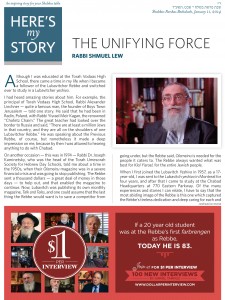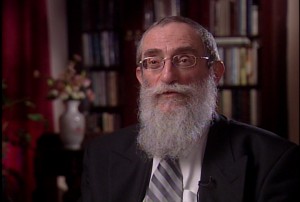HMS: The Unifying force
Although I was educated at the Torah Vodaas High School, there came a time in my life when I became a follower of the Lubavitcher Rebbe and switched over to study in a Lubavitcher yeshiva.
I had heard amazing stories about him. For example, the principal of Torah Vodaas High School, Rabbi Alexander Linchner – quite a famous man, the founder of Boys Town Jerusalem – told one story. He said that he had been in Radin, Poland, with Yisrael Meir Kagan, the renowned “Chofetz Chaim.” The great teacher had looked over the border to Russia and said, “There are at least a million Jews in that country, and they are all on the shoulders of one Lubavitcher Rebbe.” He was speaking about the Previous Rebbe, of course, but nonetheless it made a deep impression on me, because by then I was attuned to hearing anything to do with Chabad.
On another occasion – this was in 1974 – Rabbi Dr. Joseph Kaminetsky, who was the head of the Torah Umesorah Society for Hebrew Day Schools, told me about a time in the 1950s, when their Olameinu magazine was in a severe financial crisis and was going to stop publishing. The Rebbe sent a thousand dollars– a great deal of money in those days – to help out, and that enabled the magazine to continue. Now, Lubavitch was publishing its own monthly magazine, Talk and Tales, and one could assume that the last thing the Rebbe would want is to save a competitor from going under, but the Rebbe said, Olameinu is needed for the people it caters to. The Rebbe always wanted what was best for Klal Yisrael, for the entire Jewish people.
When I first joined the Lubavitch Yeshiva in 1957, as a 17-year-old, I was sent to the Lubavitch yeshiva in Montreal for four years, and after that I came to study at the Chabad Headquarters at 770 Eastern Parkway. Of the many experiences and stories I can relate, I have to say that the most abiding image of the Rebbe is this one which captured the Rebbe’s tireless dedication and deep caring for each and every Jew, and which forever after inspired me in my work as a Chabad shliach in London: I remember the conclusion of Simchas Torah, when the Rebbe had just spent an exhausting week, giving many lengthy discourses while standing on his feet, followed by dancing with the Torah. Then, at the end of the festival, he would personally distribute wine from his Kos Shel Brocho to thousands of people who were present – all the while, still standing on his feet. This took many hours, lasting to two or three in the morning.I recall that the young people were all exhausted, and here the Rebbe was in his late eighties, but not once did he ask: “How many more? How much longer? When will it be over?”
When the line ended, he would ask “S’iz du nuch vos darf bakumen? – Is there anyone else that needs to receive?” All he was looking for was somebody else who needed something from him.
Despite this exhausting week-long schedule, on the day after Simchas Torah in 1974, the Rebbe was receiving people again for private audiences. I went in with my son Pinny, who was five years old. The Rebbe spoke with the boy, and then something happened which I would like to share.
The Rebbe asked me if recently I had heard from a certain person, a communal figure in England. I said that, as a matter of fact, I had. I added that I had heard that this person had very strongly criticized the Rebbe for his stance on the “Who Is a Jew?” issue – this was in connection with Israel’s Law of Return, Soviet Jews, and the whole idea of Jewish identity.
The Rebbe told me the reason for this person’s harsh statements was that somebody had misinformed him about what the Rebbe had said about him in a public talk. As a result, this person believed that the Rebbe had attacked him personally. But, said the Rebbe, “I do not speak about personalities; I speak about ideas.”
As the Rebbe was saying this, I was thinking to myself, “Here is the Rebbe, the leader of world Jewry, who is totally, totally dedicated to all Jews, and not only that, he’s the best friend I have in the world.” And I decided, within a split second, that as soon as I returned to England, I would make an appointment with this communal figure and straighten things out.
As I was thinking it, at that very moment, the Rebbe said, “It’s not a good idea for you to tell him that I told you about this.”
Now, unfortunately, I’m a little bit of a wise guy, so I immediately figured out a way around. I thought, “I won’t do it, but I’ll get somebody else to do it.” I was desperate to clear things up, so that this person shouldn’t have a negative feeling about the Rebbe.
But again, as I was thinking this – this was within a split second – the Rebbe said, “And it’s not a good idea for you to ask somebody else to go speak with him because I’m telling you something which was told to me in a private conversation. And, besides, that’s not the point.”
The Rebbe went on: “The point is that there are 613 commandments in the Torah. One of them is ‘Who Is a Jew?’ If this person will not work with us on this one mitzvah, let him work with us on the other 612.” He then explained to me about how to become close with this person and how to befriend him. He described how positive this man and his family were, and how they could be forces for good.
And, to me, this became a directive for life in general: Look for the unifying force. Always look for that which you have in common with the other person and build on that. And through that commonality, you will be able to achieve your goals rather than having to fight needless battles.
Rabbi Shmuel Lew has been a Chabad shliach and educator in London, England for over forty-eight years. He was interviewed four times between 2005 and 2009 about his many encounters with the Rebbe.
This week’s Here’s My Story is dedicated
by Peter and Esther Kalms







No Comments to “HMS: The Unifying force”